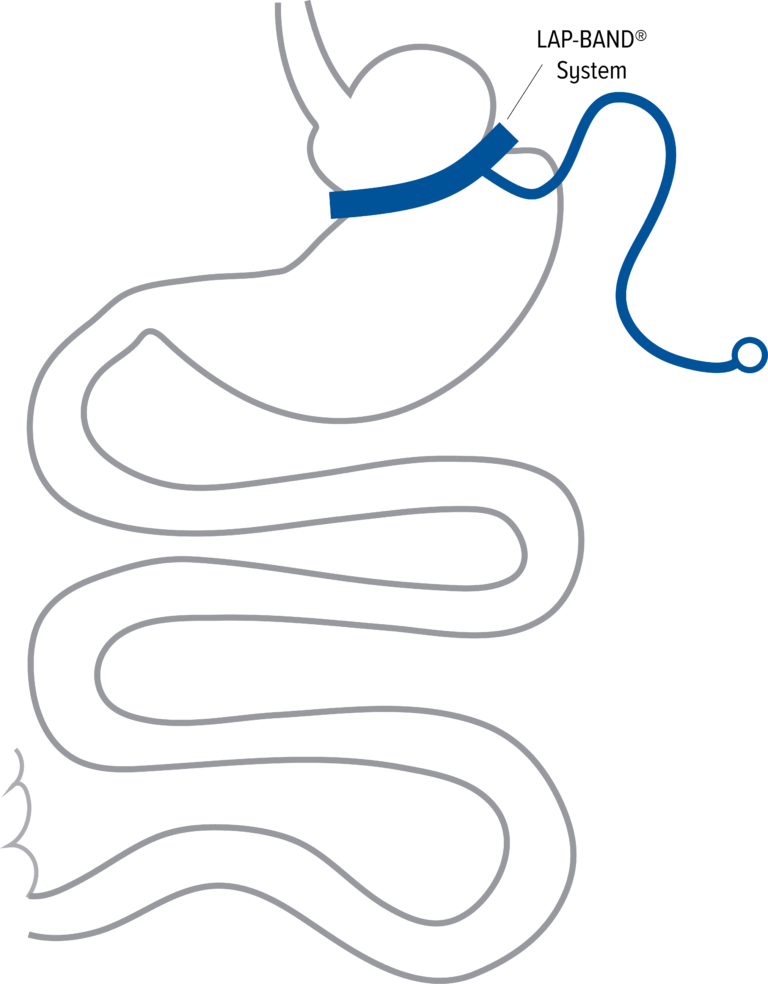Thinking About Bariatric Surgery? Let Us Help
Sign Up for an Information Session
Sign UpGet Started on the Path to Weight Loss
Get Started
Gastric Band
Adjustable gastric banding is the only adjustable bariatric surgery. It works by placing an inflatable silicone band around the top part of the stomach, which creates a small pouch and, in effect, make the stomach smaller.
This pouch holds about a half-cup of food, rather than the roughly six cups that a normal stomach holds. It fills with food quickly, which means patients won't be able to eat as much, and will feel full faster, yet it also allows them to absorb nutrients from food normally.
The band can be adjusted to meet a patient's needs. For instance, it can be deflated if a woman becomes pregnant, and it can be tightened for patients who are not losing enough weight to make a healthy difference.
Highlights
- No stomach stapling or cutting, or intestinal rerouting
- Adjustable and reversible
- Lower operative complication rate than other bariatric procedures
- Lower short-term mortality rate than a gastric bypassWhat to Expect
During the procedure, the surgeon uses laparoscopic techniques, making a small incision and using long-shafted instruments to implant an inflatable silicone band into the patient's abdomen. Like a belt, the band is fastened around the upper stomach to create a new, tiny stomach pouch that limits and controls the amount of food the patient can eat. It also creates a small outlet that slows the emptying process into the stomach and the intestines.
The band is connected by tubing to a reservoir, which is placed under the skin during surgery. To change the size of the band, saline solution is injected into or withdrawn from the tubing with a fine needle, which inflates or deflates the band's inner surface.
Internal incisions are closed with absorbable sutures and external incisions can be closed with skin glue or steri-strips. Patients have office visits to receive fluid adjustments through their port.
Surgery takes about an hour and a half and patients have a similar recovery to other bariatric procedures. Food enters the pouch and is slowed by the restrictive band.
While not common, excessive vomiting can result in band patients if they eat too quickly; take large bites of food; drink fluids with their meals/snacks; eat dry, tough or sticky foods; or have their band adjusted to where it is too tight. If these things are avoided, excessive vomiting should not be an issue.
Results
Gastric banding patients typically lose between 20-40 percent of their excess weight. The ideal patient for a band is someone who is determined to make lifestyle changes. Patients will typically lose less weight with this procedure than other surgical options. Results vary by patient.
Disadvantages
- Slower and less reliable weight loss than other bariatric procedures
- Regular follow-up is critical for optimal results: Even after reaching and maintaining success weight, patients may still need to see their bariatric surgeon for further adjustments
- Requires an implanted medical device
- In some cases, effectiveness may be reduced due to slippage of the band
- High instance of removal and revisional procedures
- Gastric banding can help patients feel satisfied sooner and with less food, but it won't eliminate the desire to eat. Patients need to follow their specific diet and exercise guidelines provided by the bariatric surgeon to achieve success.
Potential Concerns
In addition to standard surgical risks, concerns to be aware of include:
- Nausea and vomiting
- Band slippage
- Band erosion
This Surgery May Not Be Right for You
If you have these conditions, this surgery may not be right for you:
- Inflammatory disease or condition of the gastrointestinal tract, such as ulcers, severe esophagitis or Crohn's disease
- A problem that could cause bleeding in the esophagus or stomach, such as esophageal or gastric varices (a dilated vein)
- Portal hypertension, cirrhosis or pancreatitis
- Congenital or acquired abnormality of the esophagus, stomach or intestine
- Previous intra-operative gastric injury, such as a gastric perforation at or near the location of the intended band placement
- Infection
- Chronic, long-term steroid treatment
- Allergy to materials in the device
- Having—or having a family history of—autoimmune connective tissue disease. This includes diseases such as systemic lupus erythematosus or scleroderma.
What to Expect After Surgery
A hospital stay after a gastric band procedure is typically the same day, or less than 24 hours. Many patients return to normal activity within one to two weeks. Heavy lifting is restricted for about four weeks.